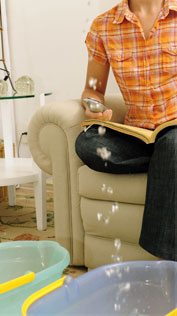 At Miller Restoration DKI, we understand how destructive water damage can be to a home or business.
At Miller Restoration DKI, we understand how destructive water damage can be to a home or business.
Water damage can be something minor or it can be as destructive as a major flood. It is important to first find the source of the problem and then to have it contained. With water damage, there are three categories of water to understand. First, clean water possesses no great risk to an individual's health. Examples are broken water supply lines, tub or sink overflows or appliance malfunctions that involve water supply lines. Second, grey water can cause discomfort and sickness. Examples are toilet bowls with urine and sump pump failures. Third, black water can cause extreme sickness and discomfort. Examples are sewage leaks, ground surface water or standing water. Generally, grey water that is not removed within 48-72 hours is then classified as black water. The trained technicians at Miller Restoration will immediately respond to any water damage and put the homeowner at ease.
Our Services
- Extraction of water and waste materials.
- Removal of damaged and contaminated building materials.
- Advanced drying equipment and applied structural drying techniques.
- Full monitoring services to ensure complete drying of the structure.
- Processing and cleaning of damaged contents and clothing.
- Full laundering and dry cleaning services.
- A detailed listing of inventory using POI software program.
- Infrared Digital Thermography for advanced moisture detection.
Our Equipment
- Newest and most efficient drying and air quality control equipment on the market.
- Advanced digital moisture detection equipment and meters.
- Hydro X Extractors for deepwater removal from floor coverings.
Water Damage Do's and Don'ts
Do...
- Call your insurance company.
- Ventilate wet areas. Turn on air conditioning for advanced drying in summer; in winter alternate between opened windows and heating.
- Remove standing water from flat surfaces.
- Turn off circuit breakers to the affected area, when access to the power distribution panel is safe from electrical shock.
- Remove saturated rugs and carpets.
- Stay out of rooms where ceilings are saturated and are at risk of collapse.
- Transport all electronics to a dry environment as long as power is off.
- Open cabinets and drawers for interior drying, but don't force any that are stuck or jammed.
- Place blocks under furniture legs to avoid carpet staining.
Do not...
- Turn on TVs, vacuums or other appliances while standing on wet carpet or floors, especially not wet concrete floors. Serious injury may result!
- Use heat to dry closed building interiors; mildew and expanded moisture damage may result.
- Leave wet fabrics in place; space them apart and dry as soon as possible.
- Use your household vacuum cleaner to remove water, possibly causing electrical shock or damage to the vacuum cleaner.
 Sewage and Flood Damage Do's and Don'ts
Sewage and Flood Damage Do's and Don'ts
Do...
- Treat all water-impacted surfaces and furnishings as toxic, until properly decontaminated.
- Keep your children and pets out of contaminated areas.
- Wash your hands after contact with contaminated water.
Do not...
- Move contaminated items into uncontaminated areas.
- Attempt to decontaminate surfaces with sprays and other over-the-counter germicidal products, which may not fully disinfect contaminated surfaces.
- Use household fans to dry structure and spread contaminants
